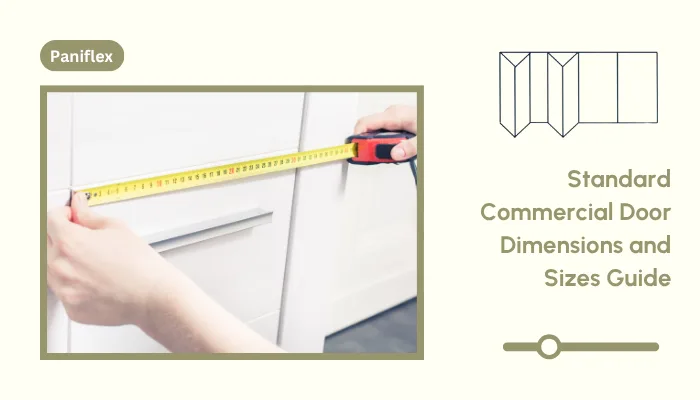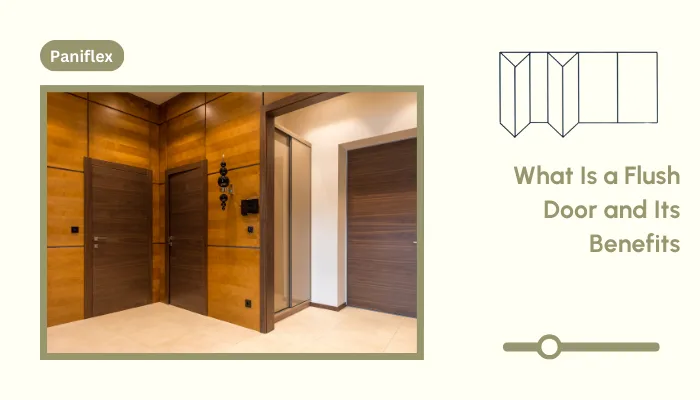Selecting the correct commercial door size is essential for ensuring accessibility and functionality in various business settings. Many building owners and managers often find it challenging to select the correct dimensions due to the varying requirements imposed by regulatory codes and the specific needs of their facilities.
We know how frustrating it can be to encounter unexpected fit issues during installation, especially when timelines are tight, and compliance is critical. This guide outlines the most common commercial door dimensions and provides insights into specialty sizes, code considerations, and custom solutions.
Ready to experience the benefits of custom closet doors? Explore our range of Paniflex products now.
TL;DR
- Standard commercial door sizes typically range from 36” x 80” for single doors to 72” x 96” for double doors, with a standard thickness of 1-3/4 inches.
- Specialty sizes are often required for lobbies, warehouses, or spaces with high ceilings and may include fire-rated or soundproof doors.
- Accurate measurement and planning are crucial to avoid common mistakes, such as overlooking hardware clearance or uneven openings.
- Building codes, such as the ADA and IBC, set minimum clear widths and heights to ensure accessibility and safety in commercial spaces.
Why Standard Commercial Door Sizes Matter
The door you install has a direct impact on accessibility, safety, and efficiency in a commercial environment. Standard sizes help simplify design planning, meet building codes such as ADA and fire safety regulations, and ensure smooth traffic flow in high-occupancy spaces, including offices, hotels, and healthcare facilities.
These are a few reasons to pay attention to the door size:
- Ensures compliance with ADA and local building codes
- Supports smooth traffic flow in high-occupancy areas
- Simplifies planning for contractors and interior designers
- Reduces installation errors and costly rework
- Matches industry-standard hardware and accessories
Ignoring these standards can result in doors that are either too narrow for equipment or wheelchair access or too wide to fit structural constraints, resulting in expensive delays.
Knowing why standard sizes are important is only half the picture. The next step is understanding the actual dimensions most commonly used in commercial spaces across the U.S.
Suggested Watch: Get essential information regarding standard dimensions for both interior and exterior doors in this video.
Common Commercial Door Sizes in the U.S.
Most commercial spaces, ranging from office buildings and hotels to healthcare facilities, rely on a set of standard door sizes to strike a balance between accessibility, safety, and design efficiency. These dimensions are widely accepted because they comply with building codes, fit most hardware systems, and simplify construction planning.
The most commonly used sizes include:
| Door Type | Standard Widths | Standard Heights | Thickness |
|---|---|---|---|
| Single Doors | 36″, 42″ | 80″, 84″, 96″ | 1-3/4″ |
| Double Doors | 60″, 72″ (pair of 30″-36″) | 80″, 84″, 96″, up to 120″ | 1-3/4″ and up |
| Specialty Doors | Custom sizes as required | Up to 120″ (10’) | Varies by design |
These are explained in detail below:
1. Width
Commercial door widths are largely standardized to accommodate varying levels of foot traffic and accessibility requirements. Here are the most common widths used in different types of buildings.
- 36 inches: The most standard single-door width, providing ample clearance for people, wheelchairs, and small equipment.
- 42 inches: Common in high-traffic areas like hospitals and schools, where wider clearance is needed.
- 60–72 inches (Double Doors): Used for main entrances, lobbies, and large conference rooms. Double doors consist of two leaves, typically each measuring 30″–36″ wide.
2. Height
Door heights vary based on ceiling heights and design preferences, with specific standards dominating across commercial projects. These are the typical height options.
- 80 inches (6’8”): The standard commercial door height for most interior applications.
- 84 inches (7’): Popular in modern commercial projects for a more spacious feel.
- 96 inches (8’): Often seen in upscale environments or buildings with higher ceilings.
- Up to 120 inches (10’): Reserved for specialty applications like grand entrances or industrial spaces.
3. Thickness
The thickness of commercial doors affects their durability, fire rating, and compatibility with hardware. These are the standard thicknesses you will encounter.
- 1-3/4 inches: Standard for most commercial doors, ensuring durability and compatibility with fire-rated requirements.
- 2 inches or more: Occasionally specified for acoustic or security doors.
These dimensions serve as a baseline for most projects. However, variations are common, depending on the type of building and its function. For example, utility rooms may use narrower doors, while lobbies or auditoriums often require oversized custom openings. These are discussed in the next section.
Suggested Read: How to Install Sliding Closet Door Floor Guides on Various Surfaces
Specialty Sizes for Commercial Applications
While standard door sizes meet most requirements, specific commercial spaces demand custom dimensions to suit their unique functions and design challenges. As a professional contractor or architect, paying attention to the door’s purpose is vital.
1. Oversized Doors
Large commercial spaces, such as lobbies, auditoriums, and warehouses, often require oversized doors to handle heavy traffic or accommodate large equipment. These doors can range from 96 inches (8 feet) to 120 inches (10 feet) in height and may span wider openings to create an impressive visual impact in entryways.
2. Narrower Doors
In areas with limited access needs, such as utility closets or restrooms, narrower doors are commonly specified. These are typically 30–34 inches wide, providing sufficient clearance for single-person use without consuming excess wall space.
3. Custom Height Doors
Contemporary architecture often features higher ceilings, requiring doors taller than the standard 80 or 84 inches. Custom-height doors may sometimes exceed 96 inches. This is generally to maintain proportionality and a sleek, modern appeal.
4. Fire-Rated and Soundproof Doors
Specialty doors designed for fire resistance or soundproofing may demand non-standard thicknesses or reinforced construction. These applications often require precise customization to meet safety codes while integrating easily into specific wall assemblies.
Whether you are drafting plans, renovating spaces, or specifying materials, understanding standard sizes helps avoid costly rework. With so many size options available, how do you know which one is the right fit? It starts with understanding the factors that shape door selection.
From the Community: Learn more about the standard door dimension ratio in this Reddit thread.
Considerations When Choosing Door Sizes
Selecting the right door size for a commercial project involves more than simply adhering to standards. Each space has unique functional, designer, and regulatory needs that influence your decision. These factors are:
- Building Type: Different commercial spaces have different needs. For example, hospitals and schools often require wider doors for the movement of equipment, while retail stores may prioritize looks and customer flow.
- Traffic Flow: High-traffic areas such as lobbies or corridors benefit from wider or double doors to accommodate large groups and prevent congestion.
- Accessibility and Codes: Compliance with accessibility standards, such as the ADA and local building codes, is essential to ensure that all users can safely and comfortably use the space.
- Looks and Proportions: The door’s size should align with ceiling heights, wall dimensions, and the overall design language to maintain visual balance in the space.
Once you have evaluated all key factors for selecting door sizes, the next step is ensuring precise measurements and a smooth ordering process. Accurate measuring and proper ordering are critical to ensuring that the chosen door size fits perfectly and complies with building codes. These are discussed in the next section.
Suggested Read: DIY Ideas for Replacing HVAC and AC Closet Doors
How to Measure and Order a Standard Commercial Door?
Getting accurate measurements is the first step toward a successful door installation. Even standard-sized commercial doors require precise planning to ensure they fit correctly within the opening and meet code requirements. A few careful steps can save you from costly errors and delays.
- Start with the rough opening: Measure the width and height of the rough opening, not the existing door slab. This accounts for framing and hardware space.
- Measure at three points: Take width and height measurements at the top, middle, and bottom of the opening. Use the smallest measurement for ordering to accommodate any irregularities.
- Check the wall thickness: Make sure you include the frame and any additional layers, such as drywall or paneling, when determining the jamb size.
- Account for hardware clearance: Plan for hinges, closers, thresholds, and panic bars that may require extra space.
- Verify code compliance: Ensure measurements align with ADA, fire safety, and local building codes before finalizing your order.
Even with careful measuring and planning, mistakes can still happen, especially in complex commercial projects. Overlooking minor details or relying too heavily on assumptions about standard sizes often leads to costly errors and delays.
In the next section, we will discuss the most common mistakes professionals encounter when sizing commercial doors and how to prevent them.
Common Mistakes to Avoid When Sizing Commercial Doors
Even experienced professionals can run into challenges when specifying commercial door sizes. Minor oversights during the planning and measurement stages often lead to delays, extra costs, or code violations. By understanding common pitfalls and knowing how to avoid them, you can ensure a smoother process from design to installation.
Mistake 1: Measuring Only the Existing Door Slab
Always measure the rough opening instead of the door slab. The rough opening accounts for framing, shims, and hardware clearances, which are critical for an accurate fit.
Mistake 2: Ignoring Floor and Ceiling Variations
Check for uneven floors or ceilings before placing your order. Take multiple measurements at different points and use the smallest measurement to prevent gaps or binding during installation.
Mistake 3: Overlooking Hardware and Clearance Needs
Plan for door swings, thresholds, and hardware, such as panic bars or closers. Ensure there is enough wall and floor space to accommodate them without obstructing pathways.
Mistake 4: Neglecting Building Code Requirements
Familiarize yourself with ADA standards, fire safety codes, and local building regulations. This avoids ordering doors that do not meet mandatory clearance or egress requirements.
Mistake 5: Assuming Standard Sizes Will Always Fit
Evaluate each opening individually. Older buildings, renovations, or unique architectural designs often require custom-sized doors for a great finish.
Understanding these common mistakes is the first step to avoiding them. The next is applying simple, practical techniques that make measuring and ordering faster, more accurate, and less stressful. These quick tips will help you set up your project for success.
Suggested Read: Installing Sliding Closet Doors Over Carpet
Quick Tips for Measuring and Ordering
Accurate measurements are the foundation of a successful door installation. Even a minor miscalculation can lead to costly delays or poor fits. Following a few simple guidelines when measuring and placing orders can save time, money, and frustration during your commercial projects.
- Measure the rough opening: Always measure the width, height, and depth of the rough opening to account for framing and hardware clearances.
- Take measurements at multiple points: Measure width and height at the top, middle, and bottom. Use the smallest measurement to ensure the door fits in slightly uneven openings.
- Account for floor and ceiling variations: Check if the floor is level and the ceiling is even. This helps prevent gaps or binding during the installation process.
- Confirm hardware and clearance needs: Plan for door swings, thresholds, and hardware that may require additional space beyond the door size itself.
- Double-check local code requirements: Verify dimensions against ADA or fire safety codes before placing your order to avoid compliance issues later.
Following best practices for measuring and ordering helps avoid common pitfalls. Still, there is another key decision to make before finalizing your specifications: Should you opt for a standard commercial door size or invest in a custom solution? The answer depends on your project’s design, functional needs, and compliance requirements.
Standard vs Custom: Which Is Right for Your Project?
While standard commercial door sizes are suitable for most applications, there are instances when only a custom solution can meet the unique needs of a space. Deciding between standard and custom doors depends on your project’s requirements for functionality, compliance, and design.
When to Choose Standard Sizes
Standard commercial door sizes are a practical choice for most projects, offering cost efficiency and simplicity when the openings align with industry norms.
- Ideal for new construction where openings are designed for standard dimensions.
- Faster lead times and easier sourcing from manufacturers.
- Compatible with off-the-shelf hardware and frames.
- More cost-effective for projects with multiple identical doorways.
When to Consider Custom Sizes
Custom door dimensions become essential when a project involves unique design requirements, irregular openings, or compliance with specialized building codes.
- Renovations or retrofits in older buildings with irregular openings.
- High-end projects that require non-standard dimensions due to design specifications.
- Spaces requiring oversized doors for equipment or traffic flow.
- Compliance with specialized codes (e.g., fire-rated or soundproof requirements).
If you believe a custom door is the best fit for your project, the next step is to find a partner who can deliver precision, quality, and reliability. This is where Custom Door & Mirror stands out, offering tailored solutions that meet the unique demands of commercial spaces.
Choose Custom Door & Mirror for Precision Fit Solutions
When your project requires doors that break free from standard sizing, Custom Door & Mirror delivers high-quality solutions tailored to your exact specifications. Their expertise ensures that every custom-made door fits perfectly and meets the highest standards of functionality and design.
Key Features of Custom Door & Mirror Solutions:
- True to Fit Guarantee: Every door is custom-engineered to accommodate uneven walls, floors, and non-standard openings for a flawless installation.
- Extensive Customization Options: Choose from a wide range of materials, finishes, mirrored panels, and hardware to match any commercial design.
- Lifetime Warranty: Durable components ensure long-lasting performance in high-traffic commercial environments.
- Precision Manufacturing: State-of-the-art techniques for consistent quality and exact dimensions.
- Expert Support for Professionals: Responsive service tailored for contractors, architects, and interior designers managing complex projects.
Selecting the right door size is critical to the success of any commercial project, whether you are working with standard dimensions or require a fully customized solution. With Custom Door & Mirror, you gain a trusted partner who understands the demands of commercial spaces and delivers doors that combine precision, durability, and design excellence.
Ready to experience the benefits of custom closet doors? Explore our range of Paniflex products now.
Conclusion
Choosing the right door size is necessary for accessibility, safety, and the overall success of any commercial project. From understanding standard dimensions and specialty sizes to avoiding common mistakes and applying best practices for measurement, careful planning ensures a good fit and compliance with building codes.
For projects where standard sizes are insufficient, custom solutions provide the flexibility to meet unique design and functional requirements. When your project demands doors that go beyond standard sizing, Custom Door & Mirror offers solutions tailored to your specifications. With decades of expertise and a commitment to quality, they help contractors, designers, and architects deliver doors that fit flawlessly and elevate commercial interiors.
Ready to get started? Contact us today to explore custom solutions for your next project.
Frequently Asked Questions
- What are standard commercial door sizes?
Standard commercial doors are typically 36 inches wide and 80 inches tall, with a thickness of 1-3/4 inches. Double doors often measure 60–72 inches wide. Heights of 84 and 96 inches are also standard in commercial spaces.
- What is the width of a commercial ADA door?
According to ADA standards, a commercial door must provide a minimum clear opening width of 32 inches when the door is open at a 90-degree angle. The most common ADA-compliant door width is 36 inches, ensuring accessibility.
- What is the building code for commercial exterior doors?
Building codes require commercial exterior doors to comply with safety, egress, and accessibility standards. They must meet minimum width, height, and fire-rating specifications, often including panic hardware and ADA clearance for emergency exits and accessibility.
- What is the minimum clear width of each door opening in a commercial building?
According to building codes such as the IBC and ADA, the minimum clear width for a commercial door is 32 inches. This measurement ensures sufficient space for wheelchairs and safe egress during emergencies, especially in high-occupancy buildings.






